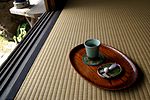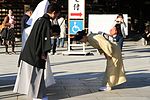Tea utensils (茶道具, chadōgu) are the tools and utensils used in chadō, the art of Japanese tea. Tea utensils can be divided into five major categories:...
42 KB (4,962 words) - 20:49, 22 October 2024
The Japanese tea ceremony (known as sadō/chadō (茶道, 'The Way of Tea') or chanoyu (茶の湯)) is a Japanese cultural activity involving the ceremonial preparation...
63 KB (7,633 words) - 20:56, 1 October 2024
The Special utensils (名物 meibutsu) are historic and precious Japanese tea utensils (茶道具). They consisted of important tea bowls, kettles, spoons, whisks...
6 KB (592 words) - 12:46, 26 June 2023
prepares his utensils, a tea caddy filled with tea powder. Next to the box, the host places a silk towel to dry the utensils after use. When the tea-making...
104 KB (13,113 words) - 08:14, 22 November 2024
The history of tea in Japan began as early as the 8th century, when the first known references were made in Japanese records. Tea became a drink of the...
24 KB (3,158 words) - 16:28, 15 October 2024
Chagama (redirect from Kama (Japanese tea ceremony))
Chagama (茶釜, "tea kettle") is a Japanese term referring to the metal pot or kettle used in the Japanese tea ceremony. Kama are made of cast iron, and...
4 KB (511 words) - 04:18, 21 September 2023
Hibachi (category Articles containing Japanese-language text)
brazier Japanese tea utensils § Tea hearths Chagama Tetsubin Japanese cuisine "'Hibachi' Probably Doesn't Mean What You Think It Does". Japanese Food Guide...
6 KB (518 words) - 03:28, 13 July 2024
Chawan (redirect from Tea bowl (without lid))
Warijūmonji Kōdai) List of Japanese tea ceremony utensils Yunomi, teacups used in Japan for everyday use Kodansha encyclopedia of Japan, Volume 2. Tokyo: Kodansha...
14 KB (1,621 words) - 05:25, 18 September 2024
Matcha (redirect from Green tea powder)
consumed differently from tea leaves or tea bags, as it is suspended in a liquid, typically water or milk. The traditional Japanese tea ceremony, typically...
50 KB (6,225 words) - 23:00, 30 October 2024
Hishaku (category Japanese tea utensils)
and purpose, and some are made of metal or plastic. The hishaku used for tea ceremony is different in size and length from the general hishaku. When a...
2 KB (293 words) - 11:53, 2 October 2023
Chashitsu (redirect from Japanese Tea house)
Chashitsu (茶室, "tea room") in Japanese tradition is an architectural space designed to be used for tea ceremony (chanoyu) gatherings. The architectural...
20 KB (2,439 words) - 20:39, 2 June 2024
Murata Jukō (category Articles containing Japanese-language text)
known in Japanese cultural history as the founder of the Japanese tea ceremony, in that he was the early developer of the wabi-cha style of tea enjoyment...
7 KB (795 words) - 14:51, 30 May 2024
Chakin (category Japanese tea utensils)
Chakin (Japanese: 茶巾 "tea towel") is a small rectangular cloth used to wipe teabowls called chawan. It is a part of Japanese tea utensils. It is also...
2 KB (202 words) - 13:26, 26 May 2024
Chaki (category Japanese tea utensils)
Chaki (茶器) is a Japanese term that literally means "tea implement". In the vocabulary of Japanese tea ceremony, it broadly means (1) any implement used...
10 KB (1,226 words) - 01:30, 4 August 2024
Tetsubin (category Japanese food preparation utensils)
for drinking purposes, such as for making tea. Tetsubin are traditionally heated over charcoal. In the Japanese art of chanoyu, the special portable brazier...
5 KB (617 words) - 11:13, 7 November 2024
Kintō (category Japanese tea utensils)
Kintō (Japanese: 巾筒) is a small tube or vessel used to store a chakin cloth during the serving of tea. It is a part of Japanese tea utensils. The container...
1 KB (122 words) - 06:45, 11 October 2022
Nagoya (redirect from Nagoya, Japan)
gifts made. In the town itself Toyoraku ware and Sasashima ware Japanese tea utensils were made with refined tastes. Ofukei ware started under the first...
94 KB (8,277 words) - 14:49, 24 November 2024
Uji tea (宇治茶, Uji-cha) is a common name for all Japanese green tea produced from Uji, Kyoto. The three main types of Uji tea are Matcha, Sencha and Gyokuro...
22 KB (2,769 words) - 08:30, 8 October 2024
specialized utensils are used when an operation is to be repeated many times, or when the cook has limited dexterity or mobility. The number of utensils in a...
29 KB (3,377 words) - 11:53, 22 November 2024
used for living utensils such as vases, pots and other everyday items, and in the Azuchi-Momoyama period, it was modified for use in tea rooms due to its...
52 KB (5,061 words) - 16:36, 29 October 2024
Sencha (redirect from Shincha tea)
Sencha (煎茶, lit. 'infused tea') is a type of Japanese ryokucha (緑茶, green tea) which is prepared by infusing the processed whole tea leaves in hot water. This...
9 KB (976 words) - 13:09, 7 November 2024
substantial fare in fall and winter. Formal tea parties are generally characterised by the use of prestige utensils, such as porcelain, bone china or silver...
11 KB (1,207 words) - 21:50, 1 November 2024
tea. Among the tasks listed to be undertaken by the youth, the contract states that "he shall boil tea and fill the utensils" and "he shall buy tea at...
86 KB (9,698 words) - 04:38, 13 November 2024
century Azuchi–Momoyama period for the Japanese regent Lord Toyotomi Hideyoshi's tea ceremonies. The original Golden Tea Room is lost, but a number of reconstructions...
16 KB (1,700 words) - 10:19, 31 August 2024
Karako (category Japanese pottery)
form on ceramic ware, it often shows boys chasing butterflies. Japanese tea utensils "Karako (Chinese Children) Playing Games - Erik Thomsen Asian Art"...
2 KB (147 words) - 07:29, 3 May 2022
excluded in cultivation and processing under abnormal conditions, and tea utensils and brewing methods that can be simplified or improvised under various...
8 KB (1,081 words) - 01:12, 9 October 2024
Shimamono (category Japanese tea utensils)
Shimamono (島物, "island objects") is a generic term for Japanese tea utensils produced outside Japan, Korea and China, mainly from Southeast Asia. Items from...
8 KB (359 words) - 17:38, 10 August 2023
Gongfu tea or kung fu tea (Chinese: 工夫茶 or 功夫茶; both gōngfū chá), literally "making tea with skill", is a traditional Chinese tea preparation method sometimes...
10 KB (1,511 words) - 21:40, 22 September 2024
take their time to admire the ornaments in the tokonoma and the utensils of the tea preparation station (点前座, Temae-za), which are all carefully selected...
30 KB (3,968 words) - 19:29, 4 October 2024



























